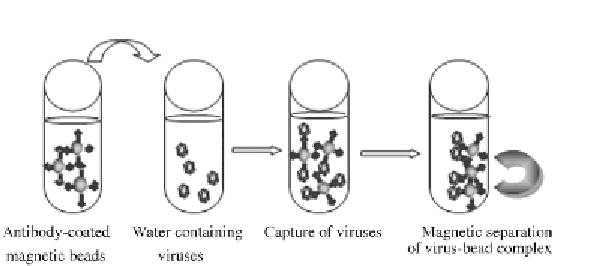Biology Reference
In-Depth Information
Figure 8.4
Immunomagnetic separation (IMS). Magnetic beads coated with antibodies
can be used to bind to antigens on the surface of target microbes in water. This figure
shows the capture of viral particles and then the concentration of the bead-attached
pathogen by a magnet. Source:
Adapted from Ref.
35
.
is extremely stable and can be reproduced from generation to generation
with high fidelity. RNA is produced directly from DNA and can represent
the metabolic activity of the cell. These molecules make excellent molecular
targets for detecting organisms and identifying specific phylogenetic sources.
The following methods are all based on the detection of nucleic acids and
take advantage of the use of this stable genotype characteristic in organisms.
8.2.3.1. Fluorescence in situ hybridization
Fluorescence in situ hybridization (FISH) coupled with confocal scanning
laser microscopy is a microscopic-based method in which samples can be
placed on microscope slides and hybridized to fluorescently labeled DNA
probes that will bind specifically to nucleic acid sequences in the cells. The
presence and location of the probe can be visualized (
Fig. 8.5
). If the probes
have been designed properly, they can be specific for sequences unique to
pathogens found in the samples. It is a powerful tool for detection and iden-
tification of specific organisms and can differentiate between dead and alive
cells; however, it lacks sensitivity and enrichment is often necessary.
38
Dilute
samples may result in false negatives; however, the concentration of samples to
increase sensitivity may increase inhibitor concentrations and the likelihood
of inhibiting the hybridization reaction thereby also causes false negatives.
The application of FISH for the detection of pathogens in water samples
has met with varying success. Although detection of
E. coli
O157 has been
successful from surface waters,
31
wastewater samples,
39
sewage,
40,41
clinical
samples, and drinking water biofilms
42
it has not been successful with quan-
tifying waterborne
E. coli
O157 from water samples with single-copy gene
probes without an enrichment step.
38

Search WWH ::

Custom Search